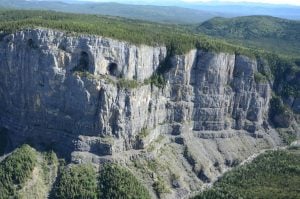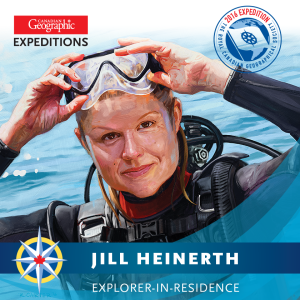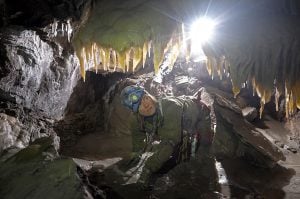
Exploration
Subterranean trailblazers
Caving: The ultimate underground sport
- 5055 words
- 21 minutes
People & Culture
The RCGS Explorer-in-Residence discusses the underwater world of cave diving, the risks involved, pushing boundaries and more

When I met Jill Heinerth, International Scuba Diving Hall of Famer, cave diver, author, scientist, broadcaster, and the Royal Canadian Geographical Society’s first Explorer-in-Residence, I was a little unnerved.
In my experience, adventurers who thrive on the dark edge of dangerous pursuits have a certain demeanour: intense, quiet, cerebral, and aloof; it’s as if they feel the strain of ten thousand hair-raising moments you couldn’t possibly understand. Jill Heinerth, on the other hand, is genuinely warm, personable, approachable and upbeat. Despite her many acclaimed and incredible feats, she felt like a “normie” I could just as easily have met at the beach. I wondered how on Earth she came to do what she does, successfully navigating the deepest underwater caves, diving beneath icebergs, or ducking beneath Arctic ice to avoid a charging polar bear. Jill enthusiastically shares these and other riveting stories in her books, films, keynotes and other platforms. I caught up with her while she hosted a Can Geo Adventure in Peru to learn more about her remarkable career and what she’s learned along the way.

Stumble may indeed be the right word! It is a gradual progression that turned me into a 30-year overnight success. I have always been a water baby and drawn to fulfill my curiosity about the world. After a short but successful career as an artist, I decided that working indoors was not going to work for me. I sold everything I owned and struck off to the Cayman Islands to gain more time underwater. I wrote articles and improved my photography, sending prints and stories around the world to interested publications. In those days (pre-internet), it was often a long wait for results. Today, I still never quite know where the next paycheck will emerge from, but I have diversified my abilities so that I can combine speaking, writing, photography, research and consulting to make a fulfilling career. If I had one thing to credit for the progression, it is the act of volunteering. Volunteering and working hard opened doors for me and put me in close proximity to people that figured it all out.
People often think that I must be fearless, but that could not be further from the truth. I am willing to embrace fear and step into the darkness in the service of scientific exploration and educational outreach. Before each dive, I have to go through a list of things that could kill me and ensure that I have the skills and equipment redundancy to deal with anything that can come my way. There are some days that I am not fit for the water, and I choose to abort. With everything in order, I can leave the anxiety and worry on the surface, knowing that I have planned and prepared accordingly. I’ll pick up those emotions when I get back to the surface after the dive.
I was in Greenland filming for The Nature of Things when the cave accident occurred. Had I been home, I would have gone there to assist since most of the rescuers are my friends and expedition colleagues. Each morning I spoke to the media to describe the unfolding events before doing my own work, and I was so proud of their efforts. Most people do not realize that we have a sort of a phone tree of contacts of people in the cave diving community who can be called to assist in what are ordinarily body recoveries… not rescues. We make these efforts without compensation, taking risks as a service to our community and to lessen the likelihood that an untrained person will get killed trying to help. I am incredibly proud of the team that made it to Thailand, those that were seen in documentaries and those who are not known to the public. They did a heroic thing and took incredible risks to make the impossible possible. We are all very proud!

It is very challenging to find funding to support this weird sort of career. I have had to become a generalist in a way, mastering many different skill sets to pay the bills. Oftentimes, funding only goes to charitable organizations that can produce a tax receipt, and that is not us. Other times, the funding goes to educational institutions and most often, logistics are covered but not a paycheck for the explorer. Funders assume that we have a salary from a school or organization. True explorers are independent, and therefore, we find other ways to pay the bills, like making TV shows, writing, speaking and consulting. Most often for me, I find at least the support for logistics, go away without a paycheck and hope that I can turn those stories into future assets that will support my husband and I. It is incredibly difficult, but I would not turn back the clock to sit back at my drafting table. I would wither working inside.
I am a technical explorer that embraces better life support, newer cameras, and survey technology. It is naive to think that the human explorer will be replaced. This is an exciting era. I have functioned as a test pilot and assisted in the development of new rebreathers, 3D mapping devices, robotics and special cameras. These tools extend my range and improve our understanding of the world. We are in a race against time to solve critical issues of climate change and water scarcity. We need to employ all the tools we can to accelerate our knowledge about the world around us. Traditional scientific research takes too long. We need an army of citizen scientists, armed with good technology and training to enhance the pool of scientific knowledge. We also need good science communicators that can help humanity to understand the relevance and importance of doing such work. The world cannot wait for traditional cycles of research, writing, peer review and publication that ends in a paper that an average person cannot understand, stuffed behind a paywall. We have to do better and we have to work together.

As a woman of 58 years, I should not have seen so many changes in her world. The tropical coral reefs are almost completely destroyed. Aquifers around the world are overdrawn resulting in a dwindling of flow in springs. In caves, I am able to swim through the veins of Mother Earth, in the essence of the planet and I can see that she is sick. There are chemicals, microplastics and refuse found in underwater caves. Few people recognize the importance of groundwater to their lives, but I can tell you that everything you do on the surface of the earth will be returned to you to drink. Whether you live in Flin Flon or Cold Lake, you have an impact on the ocean. Water soaks into the ground and travels laterally. I see it in caves. From high elevations to low, the groundwater carries the refuse of society to eventually reach the ocean. The oceans are the lungs of the planet, providing more than half of the oxygen that we breathe. If the water system collapses and the ocean continues to decline, we will all be gasping for breath.
Caves are like museums of natural history. We can discover the roots of civilizations that have left remains in these places. We can study unique biology that leads to discoveries in pharmacology and chemistry. We can learn about Earth’s past climate from the rocks and sediments. Caves are also a testing ground for technologies bound for space. From life support systems to survey and visualization technologies, many are first tested and developed in the inner space of caves.
Listen to your heart. Do not dive unless you are ready for self-rescue and buddy rescue. This is not a sport to put on a vacation mindset and rely on a guide. The rewards are tremendous, but do it with the full knowledge of risks. Prepare and practice and stay within your limits.
Travel to foreign destinations with a ton of dive and camera gear is challenging. Getting there is the least fun part of my job. I don’t mind maintenance. In fact, I love tinkering and inventing. The most difficult thing is being away from my husband. He is a supportive and loving soul, and I miss him dearly when I am off on an expedition. That said, he respects my love of exploration and knows that each time I come home, life will be a little sweeter.
I have not yet spent time in Churchill, Manitoba… only stopping over on a flight. I would love to spend time there with the polar bears and belugas. Most of all, I want to get back to the floe edge in the Arctic for a unique project that will communicate the dire situation of the loss of sea ice in a way that will captivate hearts and minds. I can’t give too many details, but given the chance, I have a unique concept that has only a few more years of potential!
Jill’s excellent book Into the Planet, is widely available.
To learn more about Jill’s speaking, visit RCGS Speakers.
Are you passionate about Canadian geography?
You can support Canadian Geographic in 3 ways:

Exploration
Caving: The ultimate underground sport

Exploration
2022 is the International Year of Caves and Karst. Here’s why you should care about the hidden worlds beneath our feet.

People & Culture
Cave diver Jill Heinerth is one of Canada’s greatest explorers and a world-leading technical diver. She's also the RCGS's very first Explorer-in-Residence.

Exploration
Seven years after it was first explored, the B.C. cave known as Raspberry Rising is still giving up its secrets, from breathtaking mineral deposits to promising antibacterial microbes